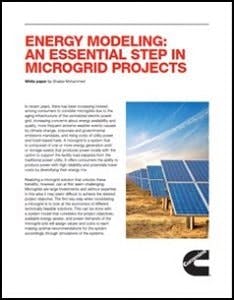A new white paper from Cummins explores how energy modeling can be used to determine microgrid feasibility without any major upfront costs.
Get the full report
An aging energy infrastructure, extreme weather events, new emissions mandates and the rising cost of energy are driving many businesses to look for reliable, cleaner and more affordable energy sources. According to a new white paper from Cummins, these factors are driving the growing interest in microgrids. The author notes that “the first key step when considering a microgrid is to look at the economics of different technically feasible solutions.” This analysis can be done with an energy modeling system.
The paper focuses on techno-economic modeling, which uses the financial, environmental and technical inputs of a project in virtual simulations. “Typically, a model will evaluate hundreds, if not thousands, of different scenarios, over a defined period, to determine the most efficient and effective system architecture for a given project and its location,” according to the paper. Because the energy models are simulation based, they can be quickly modified based on new information and without significant expense.
Energy modeling is a very helpful tool to determine the feasibility of a project without any major upfront costs. It is a critical first step for iteratively developing, validating and optimizing potential system approaches. — Cummins, “Energy Modeling: An Essential Step in Microgrid Projects”
In addition to outlining key benefits of energy modeling, Cummins provides guidance on the critical data points needed to create a successful microgrid feasibility model. First, it’s important to understand the objectives of the microgrid project. Is it to reduce system operation costs, manage capital expenses, reduce emissions or improve resiliency? Is it some combination of all of the above?
The second critical component to understand is the load profile. Cummins explains how to gather accurate load profile data because “the more accurate the load profile data, the more accurate the model results will be.”
Fuel costs and availability, space constraints, power outages and available incentives are also key data points for creating a successful energy model. Download the paper for free from the Microgrid Knowledge white paper library.








